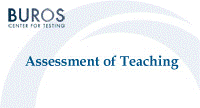Buros-Nebraska Series on Measurement and Testing

Assessment of Teaching: Purposes, Practices, and Implications for the Profession
Date of this Version
1990
Document Type
Article
Citation
Assessment of Teaching: Purposes, Practices, and Implications for the Profession, edited by James Y. Mitchell, Jr., Steven L. Wise, and Barbara S. Plake; Series Editor Jane Close Conoley (Hillsdale, New Jersey, Hove & London: Lawrence Erlbaum Associates, 1990)
Abstract
The sirens of Greek mythology were a seductive set of women who, by singing melodies that apparently topped even those of Diana Ross and the Supremes, could lure mesmerized men to their doom. Greek mythology, it is clear, was solidly sexist, for the sirens used their supernatural singing talents to entice only unsuspecting males into trouble. Gender-equity considerations were conspicuously absent from the forays of Greek fablemakers. Sexism aside, however, it is certain that the sirens of yesteryear knew how to sing some truly enticing tunes.
FACE VALIDITY'S ALLURE
In today's current frenzy to develop teacher assessment devices that tap truly important dimensions of a teacher's skills, astute observers will recognize a melody subtly reminiscent of the ancient sirens' top 10 hits. The seductive refrain to which I refer is face validity or, as it can be more pedantically described, verisimilitude. With ever-increasing frequency, the architects of teacher tests are striving to create assessment instruments that simply reek of face validity, that is, assessment approaches consonant with the actual day-to-day requirements of teaching. Face validity is being touted by some as a genuinely indispensible element of new, more defensible teacher assessment devices. Paper-and-pencil tests, particularly those of the multiple-choice genre, are regarded by these new face-validity enthusiasts as assessment tools of a benighted past in which teacher tests yielded inferences of only debatable validity.
Many educators' experience with multiple-choice teacher tests has been based on the National Teacher Examinations (NTE) developed by the educational Testing Service (ETS). NTE tests have been available for some time. They deal not only with general knowledge and pedagogy, but also with an array of special subject fields such as chemistry and French. Originally constructed to assess the consequences of teacher preparation programs, NTE tests have recently been used in various states as part of licensure systems for prospective teachers. One suspects that when critics disparage multiple-choice teacher tests, they are generally thinking of the sorts of examinations that they imagine the NTE to represent.1
As indicated earlier, a dominant reason that today's teacher testers are scurrying from multiple-choice teacher tests is that examinees' responses to such tests do not resemble what goes on in teachers' classrooms . Instead, a new cadre of teacher testers is currently striving to create assessment approaches simply swimming in face validity, that is, assessment approaches unquestionably parallel to the activities in which classroom teachers must engage.
Webster's Dictionary defines an object possessing verisimilitude as one "having the appearance of truth." Therein, of course, is the attraction of face validity. It looks so appropriate. The appeal of verisimilitude in testing is compelling. But is that appeal warranted in the case of teacher testing?
Prior to looking more carefully at the pros and cons of face validity, we need to consider the various kinds of teacher tests to which face validity may be germane. Before doing so, however, it will be useful to engage in a bit of preliminary term tidying, for there is the potential for substantial confusion in the way that educators employ two key terms, namely, licensure and certification. Historically, many states have awarded teaching certificates to prospective teachers at the close of their teacher-education programs. Thus, the use of a test in conjunction with this process would typically lead us to describe such a test as a "teacher-certification" test.
Yet, in recent months the efforts of Lee Shulman and his Carnegie- supported associates (Shulman & Sykes, 1986) to devise what they refer to as "certification" tests has forced us to be more circumspect in using teacher-test descriptors.2 Shulman employed the expression "certification test" to describe a test used with experienced, incumbent teachers. His use of the adjective certification coincides with the idea of a certified public accountant, this is, a professionally sanctioned, superior accountant. (Not all accountants, of course, are certified.) A certified teacher, to Shulman and his colleagues, is an incumbent teacher who has demonstrated clearly superior competence. Only a modest proportion of American teachers would, therefore, achieve such a state of certified excellence. Shulman would prefer to describe end-of-teacher training tests as licensure tests.
Included in
Educational Administration and Supervision Commons, Educational Assessment, Evaluation, and Research Commons


Comments
Copyright © 1990 by Lawrence Erlbaum Associates, Inc. Digital Edition Copyright © 2012 Buros Center for Testing. This book may be downloaded, saved, and printed by an individual for their own use. No part of this book may be re-published, re-posted, or redistributed without written permission of the holder of copyright.